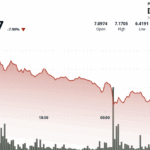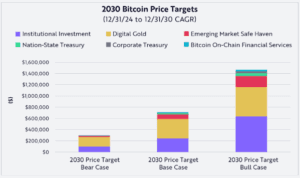
How a Futures Trade Resulted in a $29 Billion Loss in Gold Bullion and Disrupted the Atlanta Fed’s Model
On a frigid January morning at Zurich Airport, the buzz around rare metals sparked as workers carefully loaded massive pallets of gold—99.5% purity—onto a chartered 747 destined for New York.
The gold aimed for a COMEX vault, where regulations focus on bar size rather than purity levels. It originated from vaults in London and was initially cast in 400-ounce bars, which met one market’s standards but did not align with those of another market.
To execute U.S. futures contracts, the gold needed to be processed in Swiss smelters, where it was melted down and reformed into 100-ounce or kilobar sizes.
With each newly minted block, a customs declaration was triggered, classified under HS code 7115900530 for “finished metal shapes of gold.” Despite no ownership changes or additional value, the asset was merely being reformatted.
Customs, however, recorded the total market value at every stage of transit. Gold moved from London to Zurich, then to JFK, accruing monetary value at each checkpoint. Meanwhile, traders pursued the profit opportunities as COMEX futures traded at a premium of $40 to $50 above the London spot price, a difference sufficient to cover refining and transport costs while securing solid profits.
In just weeks, these refined shipments from London to Switzerland surged to an astonishing $29 billion monthly. Economists from the Atlanta Fed admitted it was a scale they hadn’t witnessed in over thirty-five years of trade data.
Since the late 2024 election results, the U.S. gold market had maintained a premium over the London market, exceeding $50 in futures premiums that attracted bullion across the Atlantic like a financial magnet, according to the London Bullion Market Association.
This premium was driven by traders preemptively responding to anticipated tariffs from the President, which created an enticing opportunity for futures to outpace spot prices. Traders accessed cheaper metal in London, utilized Swiss refiners to adapt it, and netted profits when the newly formatted bars qualified for COMEX delivery.
Once the White House officially excluded precious metals from tariff considerations on April 3, the COMEX-London premium shrank to $20 per ounce, diminishing the motivation to air freight bullion.
Meanwhile, Atlanta saw a shift in sentiment.
The Fed district’s GDPNow forecasting model, updated promptly after data releases, suddenly plunged from a modest growth projection to a concerning -3.1% by late February.
Barron’s labeled this decline a “red flag,” reporting that GDPNow first indicated -3.7% before adjusting to around -2.8%, considerably lower than predictions from other models and economists.
The model’s misstep stemmed from the influx of bullion.
Atlanta overlooked a key detail. Gold bars are categorized by the Bureau of Economic Analysis as “non-monetary gold,” meaning their purchase counts as imports subtracted from GDP, even if the metal is stored in vaults rather than used in production.
The spike in January and February led to gross imports rising $22 billion above the Q4 average, equating to an annualized shortfall exceeding $265 billion. This discrepancy was noted by the Fed’s Pat Higgins as enough to alter GDPNow by 3.6 percentage points.
On March 6, the Atlanta team made adjustments to eliminate the bullion flows from the net-exports calculations. Higgins explained in an internal post that the model would now forecast a smaller decline for first-quarter real GDP growth, promising to replace the outdated version by April 30.
This change caused GDPNow to shift from deeply negative forecasts to a more modest 0.1 percent, effectively transforming projections by over 250 basis points with a simple code update.
The initial estimate for Q1 GDP ultimately came in at 0.3%, later revised to 0.2%. With the new adjustments, GDPNow’s estimate for Q2 now reflects a healthier 2% growth.
What was behind the sudden rush of metal?
Swiss customs reported a striking 192.9 tonnes of gold transported westward in January, marking a thirteen-year high, as traders grew concerned about the potential impact of a White House “reciprocal tariff” on precious metals, despite later exemptions. Rumors of tightening liquidity in London vaults, combined with the COMEX premium, intensified the metal’s movement. While the LBMA maintains robust inventory levels, market participants express caution over thin spot liquidity, leading to wider spreads and heightened arbitrage opportunities.
The BEA was accurate in its advance estimate, showing that Q1 GDP only fell by 0.3%, a far cry from economic catastrophe as statisticians exclude “valuables” like gold and silver from domestic investment figures.
Imports had a significant negative impact on growth, deducting nearly five percentage points, but this was partly due to an accounting anomaly rather than a genuine economic downturn. Higgins acknowledged that data on inventories for agriculture and utilities is incomplete, suggesting that early prints could be adjusted once more data becomes available.
What’s significant for Bitcoin enthusiasts?
Absurdity encapsulates the situation.
In 2025, the projected growth of a trillion-dollar economy teetered on the brink due to the physical reshaping of metal bars, because one country favored 400-ounce gold bars while another required 100-ounce versions.
Pallets of gold had to be shipped from London to Switzerland, melted down, recast, and transported back to the U.S., not for use in jewelry or electronics, but solely to meet COMEX delivery specifications. This was all to exploit a $50 price gap that emerged largely from a proposed tariff. It’s akin to discovering that GDP fell negative because the freight containers lacked the right dimensions.
In contrast to Bitcoin, a digital asset that is weightless, borderless, and free from factory bottlenecks, this situation appears rather ridiculous.
BTC can be sent anywhere in under ten minutes, 24/7, with assured finalization. There are no customs forms, no standardized codes, and no necessary recalibrations of national accounts.
Bitcoin cannot be subjected to tariffs, while gold imports are indeed liable to them.
There is no need to melt gold to fit it into a designated vault; a valid script and an approving miner are all that’s required. It’s almost humorous that while one monetary asset demands extensive logistics including furnaces and cargo flights to traverse markets, another crosses borders seamlessly via a QR code.
Looking ahead, the same trade-war concerns that prompted these bullion flows are still present, and Higgins cautions that the lack of another gold influx could swing Q2 forecasts in the opposite direction.
If bullion shipments stabilize, GDPNow could potentially exaggerate growth as imports decline, which is intriguing given its current projection of 2%. Conversely, a renewed premium might once again push the model downwards.
In any case, the Atlanta Fed’s readiness to adapt its forecasting model underscores a broader lesson: data analytics rely fundamentally on the accuracy of the underlying metadata.



















Post Comment